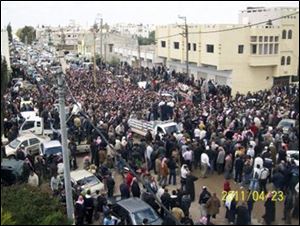
UPRISINGS IN MIDEAST
Syrian forces open fire on funeral rites
Mourners gathered to bury protesters; 11 die in 3 towns
4/24/2011
In this citizen journalism image made on a mobile phone and acquired by the Associated Press, Syrian anti-government protesters march in a funeral procession for slain activists in Izraa, Syria, on Saturday.
BEIRUT — Syrian security forces opened fire on crowds of mourners in at least three towns on Saturday as tens of thousands of people buried protesters who were killed a day earlier in the worst bloodshed since the Syrian uprising began last month.
Human rights activists and witnesses said at least 11 people were killed Saturday.
The death toll from the protests on Friday, one of the bloodiest days in the so-called Arab Spring, had risen to 109, a number that activists said was likely to increase as more bodies were returned to their families.
Another group said 114 people had been killed.
Saturday’s bloodshed followed a pattern seen frequently in the tumult that has swept the Arab world.
Funerals have often turned to protests, with calls for the fall of the national leader — in Syria, President Bashar Assad, who inherited power from his father, Hafez, in 2000. Such demands, uttered publicly, were once unheard of and serve as a marker of the degree to which outrage is overcoming fear.
Although Saturday’s death toll paled in comparison with Friday’s, it suggested the country could be entering a prolonged period of turmoil.
The Assad government has struggled to cope with the unrest, offering concessions that would have been startling at one time, while using violence against those who persist in demonstrations.
Though the revolt has drawn large numbers into the streets since it started on March 15, it has yet to achieve the critical mass of revolutions in Tunisia and Egypt.
Organizers say the bloodshed may draw more people into the uprising’s fold.
In a possible sign of cracks in the government’s facade, two members of Syria’s largely powerless parliament resigned Saturday. Khalil al-Rifai and Nasser al-Hariri, both independent lawmakers from Daraa, told Al-Jazeera they were resigning to protest the killing of demonstrators.
The government-appointed mufti, or Muslim preacher, for Daraa also resigned.
“I cannot tolerate the blood of our innocent sons and children being shed,” Sheikh Rizq Abdul-Rahim Abazeid told the Associated Press after stepping down.
Daraa has become the epicenter of the protest movement after a group of teenagers were arrested there for scrawling anti-regime graffiti on a wall in mid-March.
Wissam Tarif, the executive director of Insan, a human rights group, said security forces fired on mourners after they buried their dead.
Mr. Tarif said 11 people were killed in towns on the outskirts of Damascus, where some of the worst bloodshed was reported Friday: Douma, Barza, Maadamiah, and Qabon.